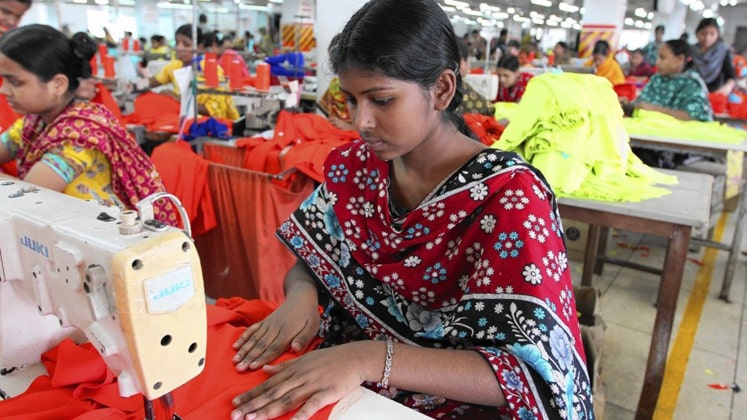
The readymade garment sector is the economic backbone of Bangladesh. The highest export earner for the country, the apparel manufacturing sector employs more than four million workers with women accounting for 85 per cent of the total workforce.
The garment industry has created a breakthrough in terms of women’s employment in the industrial sector. A supply of cheap and readily available female labour has contributed to the rapid expansion of the apparel industry. It is the hard labour of the millions of female workers that has contributed in making the garments manufacturing sector the highest export earner of the country.
However, the outbreak of COVID-19 has changed the entire dynamics; the pandemic has devastated the global garment supply chains, resulting in millions of workers being fired or furloughed. Even though all the parties are feeling the impact of this pandemic, it has been rather devastating on the workers who very rarely earn enough to accumulate any savings.
Owing to countrywide lockdowns and subsequent store closures in the West, and large-scale order cancellations by global buyers, many workers have reportedly lost their source of livelihoods.
Recently, the International Labour Organisation (ILO) has come up with findings of a survey carried out by it that threw up some interesting but concerning facts about the workforce that propels the RMG sector of the country, especially the women garment workers, who are considered the cornerstone of the industry.
As per the study titled ‘Understanding the Gender Composition and Experience of Ready-Made Garment (RMG) Workers in Bangladesh’, a staggering 97.1 per cent of women workers were still concentrated in low wage grades compared to 80.8 per cent of their male counterparts.
There are seven wage grades in the production section in the RMG sector and grade 1 is the highest paid while grade 7 is the lowest, and as per the survey report, there were more men than women in higher level positions (grades 1 and 2) in the production section, and far more women than men in lower level positions (grades 3 to 7).
While 83.8 per cent of women workers surveyed are employed in grades 4 to 7, this is true for only 67.7 per cent of male workers, the report underlined.
Also Read: From slavery risk to selling assets to meet expenses – Impacts of COVID-19 on apparel workers
The report also showed the lower representation of women in managerial and leadership positions, saying that Bangladesh could not improve in the area.
The report identified no improvements in enhancing women’s representation in managerial and leadership positions in the RMG sector in the past decade and went on to cite a report of Better Work, as per which men held 95 per cent of the line supervisor positions.
The perceptions of women and men respondents shed light on gender-based stereotypes, discrimination and norms that affect workers’ leadership roles, the report said.
‘When asked why women “are not interested in becoming supervisors”, the “intense workload” involved was highlighted by 67.7 per cent of women respondents and 51.4 per cent of men. Roughly 40 per cent of respondents suggested that women “do not feel qualified” for these roles,’ the report read.
It said that 89 per cent of women and 87 per cent of men survey respondents believed that ‘men can work faster’ than women, and men’s ‘output is greater’ than that of women.
According to the study, 73.7 per cent women respondents than 63.6 per cent men pointed out that men could work at night, while a greater proportion of male respondents noted that men did not face security problems when working or returning home late.
Over 70 per cent of all workers surveyed by the study were 29 years old or younger.
It also found that the proportion of women workers in the RMG sector declined to 60.5 per cent of total workers in 2018 from 63.4 per cent in 2010.
The ILO programme on Improving Working Conditions in the Ready-Made Garment Sector in Bangladesh Phase II, in collaboration with the UN Women Bangladesh, commissioned the study in 2017, while field data collection was undertaken in 2018.
Another interesting finding of the report pertains to violence and harassment at workplace, which are reportedly the two main reasons behind workers quitting their jobs in the garment sector.
Violence and harassment are major factors in men and women workers leaving their jobs, while pregnancy is a leading reason for women in the country’s readymade garment industry to quit jobs, according to this ILO and UN Women’s joint report.
Workers change jobs within the RMG sector fairly frequently, largely to access better salaries and working conditions. Men tend to change jobs more than women workers, it also revealed.
The study found that 60 per cent of both men and women workers surveyed experienced repeated insults and shouting from their supervisors or line managers, while about 25 per cent of the surveyed workers cited violence, and harassment at the workplaces as main reasons for leaving jobs in the RMG sector.
And 26.5 per cent reported work stress, 8.9 per cent attributed workplace injuries/occupational diseases and 5.1 per cent for consequences of worker movements.
“Pregnant workers face severe challenges and are often pressured into quitting their jobs,” it said, adding, “The average expected age of RMG worker is 36.4,” before going on to add that longer working hours, no job security, owners’ unwillingness to hire older workers and negative effects on health are other reasons for leaving the RMG sector before reaching the regular age of retirement.
“The study’s focus group discussions highlighted that work in the RMG sector is extremely physically stressful. As such, most women workers do not want to continue working in the sector until they reach the regular age of retirement.”
The report further revealed that most RMG workers are satisfied with their current employers and jobs with women workers reporting higher levels of satisfaction than men.
Factors underlying job satisfaction include the timely payment of salaries and overtime, particularly among women workers. Other frequently cited reasons are also financial, including a festival bonus, regular weekly leave, the payment of minimum wages, and a regular attendance bonus.
Another concerning finding of the report underlines that 1.6 per cent of female workers also faced sexual harassment.
Meanwhile, interacting with the media, the Managing Director of Plummy Fashions Limited and the ex-President of Bangladesh Knitwear Manufacturers and Exporters Association (BKMEA), Fazlul Hoque reportedly differed to agree on some findings of the reports like that pertaining to violence, harassment and pregnancy, which reportedly are the major reasons behind leaving jobs, while as per labour leader Nazma Akter, pregnant women do face a number of difficulties in workplaces and many of them are forced to resign on account of the same.
Notwithstanding the difference of opinions among the stakeholders in terms of some findings of the report, it definitely gives relevant and wider perspectives on various issues and challenges faced by garment workers, especially women, based on which reformative steps can be undertaken to not only improve the lot of the garment workers, but also to ensure further growth and development of the industry.
Hope things will turn for better for the garment workers in the days to come.
Also Read: New initiative to help the pandemic-hit workers in Bangladesh






